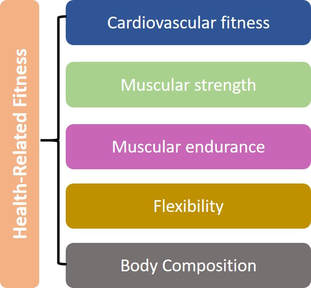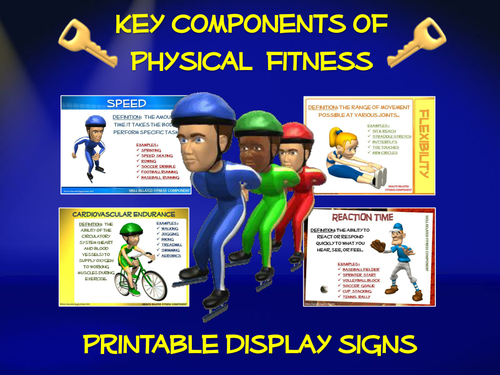Are you ready to take control of your health and feel your best every day? Understanding the key elements of physical fitness is the first step to unlocking your full potential.
When you know what makes up true fitness, you can create a plan that works for your body and lifestyle. Imagine having more energy, better strength, and improved overall well-being. You’ll discover the essential building blocks of physical fitness and how each one plays a vital role in your success.
Keep reading to find out exactly what you need to focus on to transform your health for good.
Core Elements Of Physical Fitness
Physical fitness has several important parts. These parts work together to keep the body strong and healthy. Understanding the core elements helps you know what to focus on in your workouts. Each element plays a unique role in improving overall fitness and well-being.
Cardiovascular Endurance
Cardiovascular endurance means how well your heart and lungs work during exercise. It helps you do activities like running, swimming, or cycling without getting tired fast. Good cardiovascular endurance lowers the risk of heart disease and improves energy levels.
Muscular Strength
Muscular strength is the ability of your muscles to lift heavy weights. It helps with daily tasks like carrying groceries or lifting objects. Strong muscles protect your joints and reduce injury risks.
Muscular Endurance
Muscular endurance means how long your muscles can work without getting tired. It is important for activities like climbing stairs or doing push-ups. Building endurance improves your stamina and keeps muscles healthy.
Flexibility
Flexibility is the ability to move your joints through a full range of motion. It helps prevent injuries and reduces muscle soreness. Stretching regularly can improve flexibility and make movement easier.
Body Composition
Body composition shows the amount of fat, muscle, and bone in your body. A healthy body composition means more muscle and less fat. It helps improve strength, energy, and overall health.

Credit: www.healthylifems.com
Importance Of Cardiovascular Endurance
Cardiovascular endurance is a key part of physical fitness. It means how well your heart and lungs work during activities that last a long time. Good cardiovascular endurance helps you do daily tasks with less tiredness.
It also supports overall health by improving how your body uses oxygen. Strong endurance makes your muscles work better and helps you recover faster after exercise.
Benefits For Heart Health
Cardiovascular endurance strengthens your heart. A stronger heart pumps blood more efficiently. This lowers the risk of heart disease and high blood pressure.
Better blood flow helps keep arteries clear. It reduces the chance of heart attacks and strokes. Regular activity also helps control cholesterol and blood sugar levels.
Improving Stamina
Good endurance means less fatigue during physical tasks. You can stay active longer without feeling tired. This helps in sports, work, and daily chores.
Improved stamina also boosts energy levels throughout the day. It supports a healthier lifestyle and better mood. Endurance training builds your body’s ability to use oxygen well.
Common Exercises
Walking, jogging, and cycling are simple ways to improve endurance. Swimming and dancing also increase heart rate effectively. These exercises are easy to fit into daily routines.
Consistent effort is key. Start slow and increase time or intensity gradually. Aim for at least 150 minutes of moderate activity each week.
Building Muscular Strength
Building muscular strength is a key part of physical fitness. Strong muscles help the body move better and protect it from injuries. They also improve posture and support daily tasks. Strength training involves exercises that make muscles work harder than usual. This helps muscles grow and become stronger over time.
Types Of Strength Training
There are several types of strength training exercises. Weightlifting uses free weights or machines to build muscle. Bodyweight exercises use your own weight, like push-ups and squats. Resistance bands add tension to muscles without heavy weights. Each type helps improve muscle strength in different ways.
Role In Daily Activities
Muscular strength makes daily tasks easier. Carrying groceries, climbing stairs, or lifting objects become less tiring. Strong muscles support joints and reduce injury risk. They also help maintain balance and stability. This improves overall movement and quality of life.
Safety Tips
Start with light weights and increase gradually. Always warm up before exercising to prepare muscles. Use proper form to avoid injuries. Rest between workouts to let muscles recover. Drink water and listen to your body’s signals. Consult a trainer if unsure about techniques.

Credit: www.tes.com
Enhancing Muscular Endurance
Enhancing muscular endurance helps your muscles work longer without getting tired. It improves your ability to keep moving during daily tasks and sports. Strong endurance means less fatigue and better performance.
Difference From Strength
Muscular endurance is how long your muscles can work. Strength is how much force your muscles can make. Endurance focuses on many repetitions with lighter weights. Strength uses fewer reps but heavier weights. Both help your body but serve different purposes.
Effective Workouts
Use light weights or body weight for many repetitions. Try exercises like push-ups, squats, or lunges. Aim for 12 to 20 reps per set. Rest for a short time between sets. Circuit training also builds endurance fast. Keep workouts steady and consistent for best results.
Tracking Progress
Write down the number of reps and sets you do. Note how you feel during and after workouts. Increase reps or reduce rest time as you improve. Track changes weekly to see progress clearly. Small improvements add up over time.
Increasing Flexibility
Increasing flexibility is a vital part of physical fitness. It helps the body move with ease. Flexible muscles and joints reduce stiffness. This makes daily activities and exercise more comfortable. Flexibility improves posture and balance. It also supports better performance in sports and workouts. Regular practice is key for lasting benefits.
Stretching Techniques
Stretching is the main way to increase flexibility. There are different techniques to try. Static stretching means holding a stretch for 15 to 60 seconds. This helps muscles relax and lengthen. Dynamic stretching uses movement to prepare muscles. It is great before exercise. PNF stretching combines stretching with muscle contraction. It requires a partner or a band. Each method helps improve flexibility in unique ways.
Impact On Injury Prevention
Flexible muscles lower the risk of injuries. Tight muscles are more likely to strain or tear. Stretching increases blood flow to muscles. This helps heal and reduce soreness. Flexibility also improves joint range of motion. Joints that move well avoid stress and damage. Regular stretching prepares the body for sudden movements. It protects muscles and tendons during exercise.
Flexibility Routines
Creating a routine helps maintain and improve flexibility. Start with a warm-up to increase blood flow. Follow with static or dynamic stretches. Focus on major muscle groups like legs, back, and shoulders. Stretch slowly and breathe deeply. Do flexibility exercises at least three times a week. Consistency builds lasting flexibility and supports overall fitness.
Understanding Body Composition
Understanding body composition is important for physical fitness. It shows the balance between fat and muscle in the body. This balance affects strength, health, and how the body looks. Knowing body composition helps track fitness progress better than weight alone. It guides better diet and exercise choices for a healthy body.
Fat Vs. Muscle Ratio
Body composition compares fat mass to muscle mass. Fat is needed but too much can cause health problems. Muscle helps burn calories and supports movement. A good ratio means having enough muscle and less fat. This ratio affects energy, strength, and overall wellness.
Measuring Techniques
Several methods check body composition. Skinfold calipers measure fat under the skin. Bioelectrical impedance sends a small current through the body. DEXA scans give detailed pictures of fat and muscle. Each method varies in cost and accuracy. Regular checks help track changes and adjust routines.
Maintaining Healthy Composition
Healthy body composition needs balanced eating and exercise. Protein helps build muscle. Cardio burns fat. Strength training increases muscle mass. Drinking water and resting well also support good balance. Consistency over time keeps the body fit and strong.
Nutrition’s Role In Fitness
Nutrition plays a big role in physical fitness. It gives the body fuel to move, grow, and heal. Good nutrition helps improve strength, energy, and recovery. Without the right foods, fitness goals can be harder to reach.
Eating well supports muscle building and fat loss. It also keeps the heart and bones healthy. Nutrition works together with exercise to make the body stronger and more flexible.
Balanced Diet Essentials
A balanced diet has the right mix of carbs, proteins, and fats. Carbohydrates give quick energy for workouts. Proteins help repair muscles after exercise. Fats provide long-lasting energy and support cell health.
Eating fruits and vegetables adds vitamins and minerals. These nutrients help the body work well and fight illness. Whole grains and lean meats are good choices for steady energy.
Hydration Strategies
Water is vital for fitness. It keeps the body cool during workouts. Water helps transport nutrients to muscles. It also removes waste and prevents cramps.
Drink water before, during, and after exercise. Avoid sugary drinks that can cause energy crashes. For longer workouts, sports drinks can replace lost salts and minerals.
Supplements And Their Use
Supplements can support a healthy diet but do not replace food. Protein powders help meet daily protein needs. Vitamins and minerals fill in gaps from poor diets.
Use supplements wisely and with advice from a health expert. Avoid relying on them for energy or performance boosts. Real food always comes first for fitness success.
Rest And Recovery
Rest and recovery are vital parts of physical fitness. They help the body heal and grow stronger. Without rest, muscles stay tired and weak. Recovery prevents injuries and improves overall performance. It supports the body’s ability to adapt to workouts. Proper rest and recovery lead to better results and long-term health.
Importance Of Sleep
Sleep is the best form of rest. It helps repair muscles and tissues. During sleep, the body releases growth hormones. These hormones build muscle and burn fat. Poor sleep slows down recovery and causes fatigue. Aim for 7 to 9 hours of quality sleep each night. Good sleep improves focus and energy for workouts.
Active Recovery Methods
Active recovery involves gentle exercise on rest days. Walking, swimming, or yoga are great options. These activities increase blood flow to muscles. Blood flow helps remove waste and brings nutrients. Active recovery reduces soreness and stiffness. It keeps the body moving without strain. This type of recovery speeds up healing.
Avoiding Overtraining
Overtraining happens when the body gets too much stress. It causes fatigue, pain, and poor performance. Signs include constant tiredness and trouble sleeping. Taking rest days is crucial to avoid overtraining. Listen to the body and slow down when needed. Balance workouts with rest to stay healthy and strong.
Tracking Fitness Progress
Tracking fitness progress helps you see how far you have come. It keeps you motivated and focused. Without tracking, it is easy to lose direction.
Knowing your progress helps you make smart changes. It shows what works and what does not. Tracking also helps celebrate small wins.
Setting Realistic Goals
Start with clear, simple goals. Choose goals you can reach step by step. For example, run for 10 minutes, then 15 minutes.
Realistic goals keep you from feeling frustrated. They make your journey steady and steady. Write your goals down and check them often.
Using Fitness Apps
Fitness apps make tracking easy and fun. They record your workouts, steps, and calories. Some apps even track your sleep and heart rate.
Apps remind you to keep moving. They give reports to show your progress. Pick an app that fits your needs and skill level.
Adjusting Plans
Check your progress every week or month. Change your plan if you hit a wall. Add more time or try new exercises.
Adjusting plans keeps your workouts fresh and effective. It helps avoid injuries and boredom. Always listen to your body and rest when needed.

Credit: strengthsanctuary.com.au
Frequently Asked Questions
What Are The Main Components Of Physical Fitness?
Physical fitness includes cardiovascular endurance, muscular strength, muscular endurance, flexibility, and body composition. These elements ensure overall health and functional ability. Balancing all components enhances performance and reduces injury risk. Focusing on each aspect is key to optimal fitness and well-being.
How Does Cardiovascular Endurance Improve Fitness?
Cardiovascular endurance boosts heart and lung efficiency, allowing longer physical activity. It improves oxygen delivery to muscles and increases stamina. Regular cardio exercises like running or cycling strengthen the heart, reduce fatigue, and promote overall health.
Why Is Muscular Strength Important For Physical Fitness?
Muscular strength helps perform daily tasks and supports joint stability. It enhances metabolism and reduces injury risk. Strong muscles improve posture and physical performance in sports and activities. Resistance training effectively builds and maintains muscular strength.
How Does Flexibility Contribute To Physical Fitness?
Flexibility increases joint range of motion, reducing muscle stiffness and injury risk. It improves posture, balance, and overall movement quality. Stretching exercises and yoga are effective ways to enhance flexibility and maintain physical fitness.
Conclusion
Physical fitness has many important parts. Strength, endurance, flexibility, balance, and body composition all matter. Each element helps your body work well every day. Focusing on all parts leads to better health and energy. Small steps, done often, bring great results.
Stay active and keep your habits healthy. Your body will thank you.
